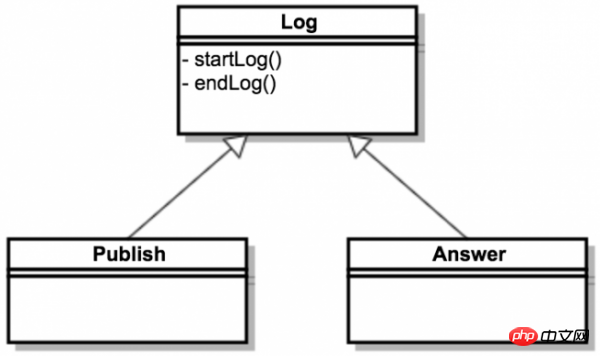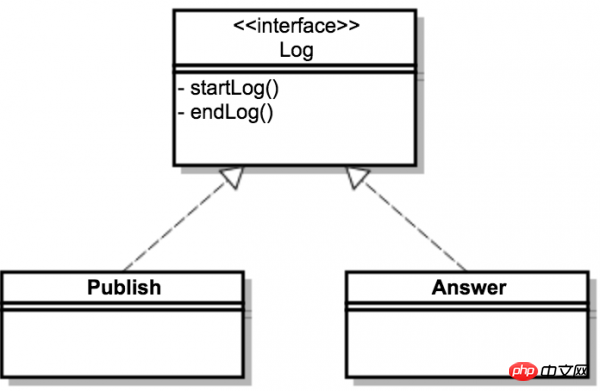1. Inheritance VS Polymorphism VS Trait
There are now two classes: Publish.php and Answer.php. To add LOG function to it, record the actions inside the class. There are several options:
Inherit polymorphic Trait 1.1. Inherit
as shown in the figure:

code The structure is as follows:
// Log.php
You can see that inheritance indeed meets the requirements. But this violates the object-oriented principle. The relationship between operations such as Publish and Answer and Log is not the relationship between the subclass and the parent class. So it is not recommended to use it this way.
1.2. Polymorphism
As shown:

Implementation code:
// Log.php
The logging operations should be the same, so the logging implementation in the Publish and Answer actions is also the same. Obviously, this violates the DRY (Don’t Repeat Yourself) principle. Therefore, it is not recommended to implement it this way.
1.3. Trait
As shown:

The implementation code is as follows:
// Log.php startLog(); $publish->endLog(); // Answer.php startLog(); $answer->endLog();
As you can see, we have achieved the code without increasing the complexity of the code. Reuse.
1.4. Conclusion
Although the inheritance method can also solve the problem, its idea violates the object-oriented principle and seems very crude; the polymorphic method is also feasible, but it is not in line with the software development process. The DRY principle increases maintenance costs. The Trait method avoids the above shortcomings and achieves code reuse relatively elegantly.
2. The scope of Trait
After understanding the benefits of Trait, we also need to understand the rules in its implementation. First, let’s talk about scope. This is easier to prove. The implementation code is as follows:
publicF(); $this->protectF(); $ this->privateF(); } } $publish = new Publish(); $publish->doPublish();
The output result of executing the above code is as follows:
public function protected function private function
It can be found that the scope of Trait is visible inside the Trait class that references it. It can be understood that the use keyword copies the implementation code of the Trait into the class that references the Trait.
3. Priority of attributes in Trait
When it comes to priority, there must be a reference object for comparison. The reference object here refers to the Trait class and its parent class.
Use the following code to prove the priority of attributes in the Trait application:
publicF(); $this- >protectF(); } } $publish = new Publish(); $publish->doPublish();
The output of the above code is as follows:
Publish::publicF public function Log::protectF protected function
Through the above example, the priority in Trait application can be summarized as follows:
Members from the current class override the trait's method and the trait overrides the inherited one. Method
The priority of class members is: Current class>Trait>Parent class
4. Insteadof and As keywords
In one class, multiple Traits can be referenced , as follows:
startLog(); $this-> parameterCheck($para); $this->endLog(); } }
Through the above method, we can reference multiple Traits in a class. When referencing multiple Traits, it is easy to cause problems. The most common problem is what to do if there are properties or methods with the same name in two Traits? At this time, you need to use the keywords Insteadof and as .Please see the following implementation code:
startLog(); $this->parameterCheck('params'); $this->csl(); } } $publish = new Publish(); $publish->doPublish();
Execute the above code, the output result is as follows:
Log: :startLog public function Check::parameterCheck parameter checkparams Check::startLog public function
Just like the literal meaning, the insteadof keyword replaces the latter with the former, and the as keyword gives an alias to the replaced method. .
When referencing Trait, the use keyword is used, and the use keyword is also used to refer to the namespace. The difference between the two is that when referencing Trait, it is used inside the class.




